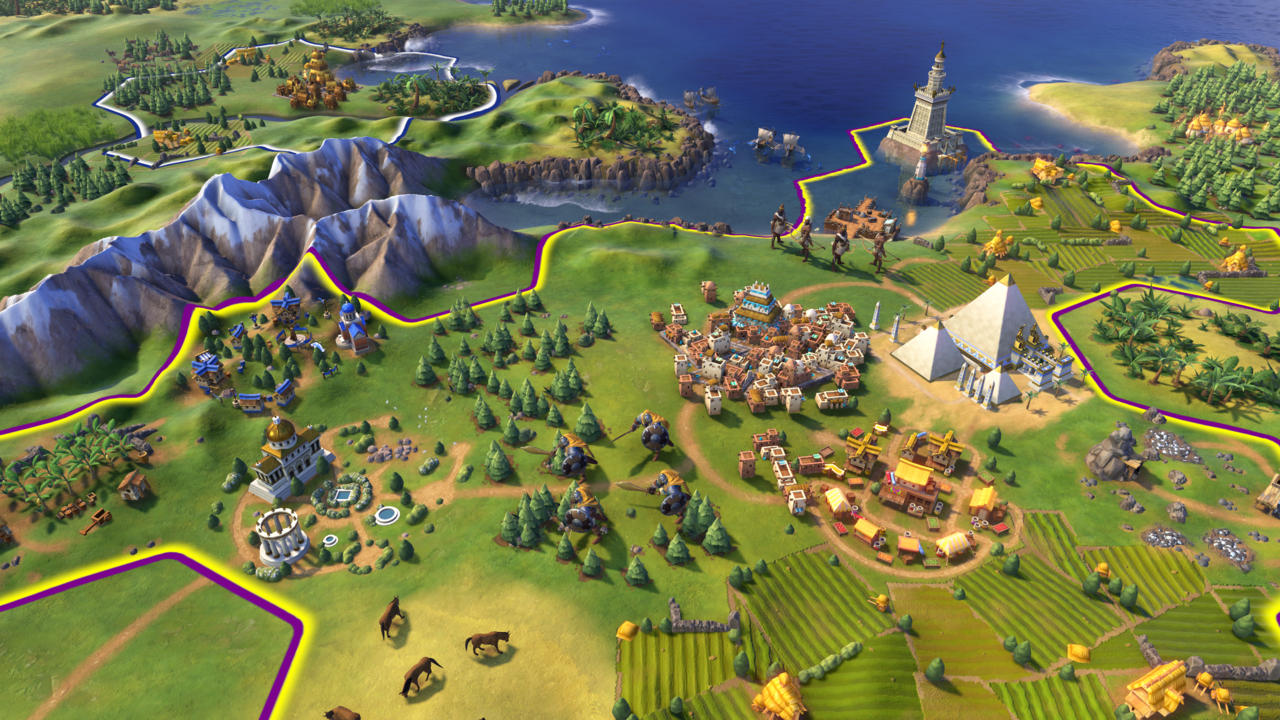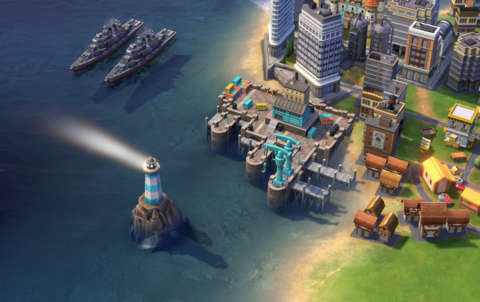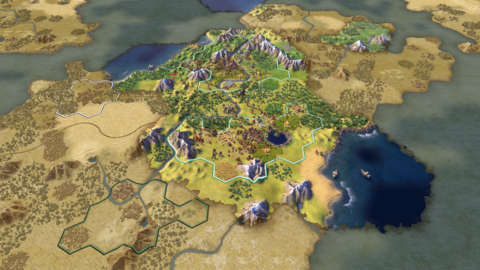The enormity of Civilization cannot be overstated. The series brashly attempts to simulate the entirety of human history over the course of 500 (or fewer) in-game turns, a process that’s as engrossing as it is exhausting. And once you’ve successfully conquered your enemies, mastered the arts, set a man on the moon, or converted the world to your belief system of choice, the process begins anew with fresh opponents, continents, and curveballs, ad infinitum.
The latest iteration of this expertly crafted, turn-based strategy drug is Civilization VI, a game that streamlines and sharpens certain aspects of Civ games past but is no less enormous for it. And as an enormous experience, fully evaluating everything on offer will take a little time. Or rather, a lot of time. I have completed a single 500-turn playthrough, though, and want to share some early impressions since the Civ 6 will be on store shelves tomorrow, October 21.

The most important point is also the most obvious: this is still Civilization. Though it adds multiple major alterations and sheds a handful of old ideas, Civilization VI still nails the core gameplay pillars that have allowed the franchise to dominate the strategy space for the past 25 years. Building cities, raising armies, researching technologies, engaging in diplomacy--growing a civilization from scratch remains an incredibly compelling hook, even after all these years, and few games can match the strategic sophistication simmering beneath the surface.
With that out of the way: yes, "unstacked cities" are indeed the biggest, most fundamental change to the Civ formula since hexagonal tiles. Now that cities sprawl outward as they grow rather than permanently occupying a single tile, you’re forced to view the map in a new way: How much space do I need to leave between my cities? How long before I’m able to utilize that resource that’s three tiles away? Selecting the perfect spot for a new settlement can be nerve-wracking, but the possibilities this system adds are an enticing reward.
Unstacking cities also means managing the ever-expanding layout of your cities rather than selecting a structure from a build menu and immediately moving on. This, too, adds a new series of possibilities and potential pitfalls: What resources will I be missing out on if I convert this tile to a structure? What if I need to build something on this specific spot in the future to, say, capitalize on an adjacency bonus? It forces you to plan ahead while remaining flexible, a hallmark of the Civ series now framed in a new way.

Most relevant to my particular playthrough, you must now manage individual cities’ housing and amenities needs rather than maintaining a global food supply and happiness level. I definitely struggled to keep up early on, mainly because I had only a vague idea how to add amenities and increase my housing supply. And though most of my cities, frustratingly, stagnated at around 11 to 12 citizens, I eventually figured out what technology to pursue in order to address my population’s needs and reinvigorate growth (protip: sewers).
Ultimately, I spent just as much time managing my cities as I did planning world domination, but I enjoyed the process. Unstacked cities introduce a layer of local, micro-strategy that plays out on a shorter time scale than the macro-level decisions we’re used to making. As a result, city planning ends up playing a prominent role throughout the game--including those often empty middle turns. It’s a welcome complement to the existing gameplay that slots naturally into Civ’s structure.
Civ 6 also introduces a host a small yet impactful ideas beyond unstacked cities. Chief among them: active research. Basically, every piece of Technology requires a certain number of turns to fully research. If you meet a Technology’s specific condition, however, you cut that research time in half. So whether I had to build a specific unit or open a certain number of trade routes, I very quickly started going out of my way to meet as many conditions as possible because that research acceleration gave me a tangible edge over my opponents.
Conditions were generally easy to meet and always logically suited the Technology they impacted, which made the whole idea of active research really easy to grasp. And importantly, there’s no punishment for failure; it’s merely a chance for skilled, attentive players to stay a step ahead of their opponents.
Call of Duty: Game Pass' Savior? | Spot On EA Sports College Football 25 | Official Gameplay Features Deep Dive Trailer Wuthering Waves - Overleveled Boss Challenge HUNTER×HUNTER NEN×IMPACT - Netero Official Character Gameplay Trailer (Japanese) Killing Floor 3 - Clot Enemy Reveal Trailer HUNTER×HUNTER NEN×IMPACT - Leorio Official Character Gameplay Trailer (Japanese) The Status of Every PlayStation Franchise HUNTER×HUNTER NEN×IMPACT - Kurapika Official Character Gameplay Trailer (Japanese) Silent Hill 2 Remake Extended Gameplay Showcase | Silent Hill Transmission May 2024 PlayStation State Of Play Full Showcase | May 2024 Astro Bot Gameplay Trailer | PlayStation State of Play May 2024 Monster Hunter Wilds Gameplay Trailer | PlayStation State of Play May 2024
Please enter your date of birth to view this video
By clicking 'enter', you agree to GameSpot's
Terms of Use and Privacy Policy
The changes don’t stop there either: Political policy cards--which can be slotted into any system of government once unlocked--add greater depth to both diplomacy and the overall strategy of government. Like unstacked cities, the political policies system essentially adds a new self-contained strategy mini-game that feeds back into the broader experience--and makes government far more interesting in the process.
Social Policies have been slightly reworked into Civics. Unlockable Civics are presented in a branching, chronological tree and gradually researched in exactly the same way as Technologies, creating an elegant, logical symmetry between the two systems. I definitely still need to adjust to the flow of the new trees, though. On more than one occasion, I unlocked a Civic or Technology only to find the next option grayed out. At one point, I’d already unlocked Satellites and Guidance Systems but had to go all the way back to Castles (which I’d skipped) in order to work my way forward to Nuclear Fission. The lines connecting all these Technologies on the tech tree didn’t make it clear exactly which prerequisites I needed, so…Castles.
I experienced other minor annoyances as well. At one point, for example, the game warned me France had nearly achieved a Cultural Victory, but when I checked the scoreboard, I discovered France was actually dead last in culture. I also found a few things to hate about the UI, like the submenus that appear when you hover over options in the build menu, eclipsing everything underneath. And perhaps most annoying, Cleopatra kept interrupting my game to denounce me. I was forced to watch the same lame, unskippable cutscene each time.

Thankfully, all the other issues I encountered were equally minor, and it’s possible my opinion of them will change over the next week--for better or worse. There’s also so much more to Civ 6 that I still need to explore. During my one playthrough, I played a fully standard match against the AI and achieved a Score Victory after pursuing both Culture and Science for most of the game. That means I still need to pursue Military and Religious Victories and continue to test the AI to see if the new Agendas really have instilled each leader with a distinct personality and playstyle.
Overall, most of the changes remind me of the approach Wizards of the Coast employed when designing the fifth edition of Dungeons & Dragons: dig deeper into the things that work; incorporate old ideas in smaller ways rather than eliminating them entirely; streamline and simplify everything else. Some annoyances emerged in the process and there’s still plenty I need to figure out, but this much is clear: it’s still Civilization, and it’s still engrossing as hell.

